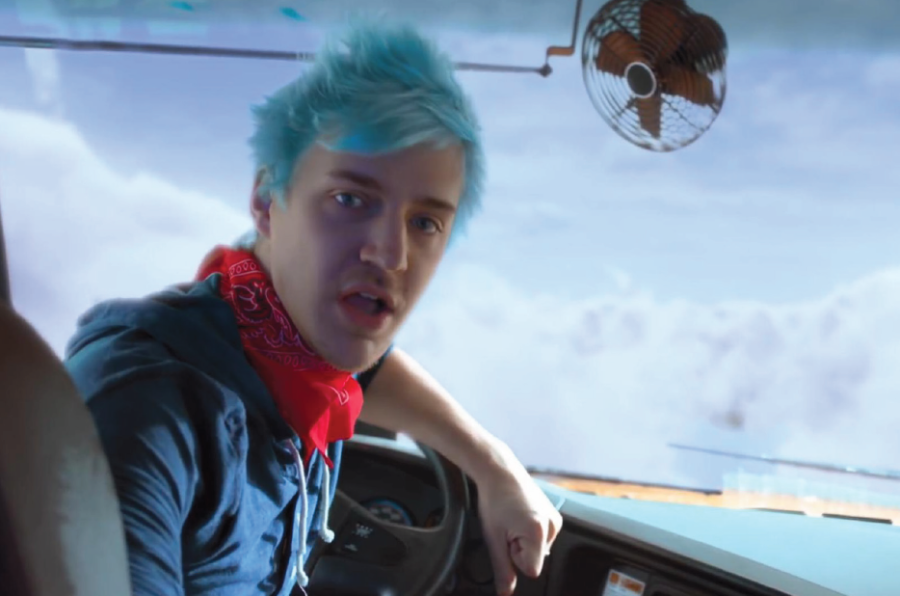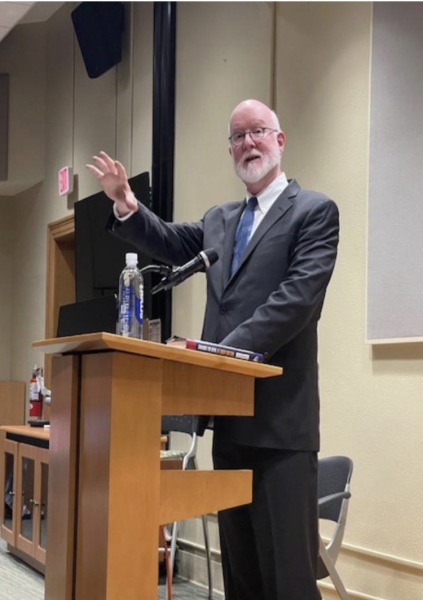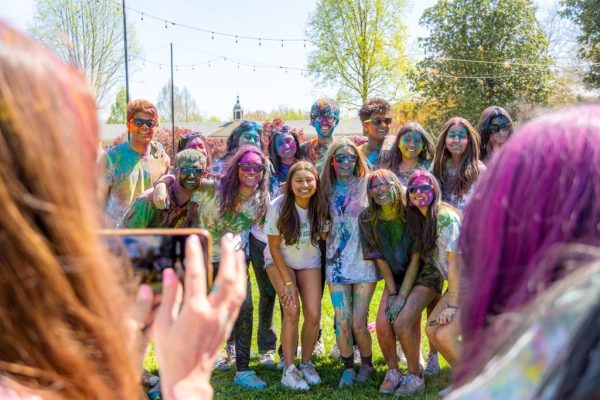YouTube Rewind and the issue with ‘nichization’
How an internet-wide meme began an indefinite period of relative isolation
Tyler “Ninja” Blevins represented the Fortnite community in You- Tube Rewind 2018 which reached almost 20 million dislikes.
April 20, 2022
No one ever thought that YouTube Rewind was that great. The music was always boring, the dancing is uncomfortable to watch, the transitions are corny and there is always a late-night host or two to make you say, “what is he even doing here?”
With that being said, YouTube Rewind used to be a lot better. In its infant stage, it was much more like a Spotify Wrapped than the disaster we saw unfold in 2018. It was simplistic and only highlighted the most viewed videos of the year. In 2011, Rebecca Black hosted the rewind — something I mention only because her song “Friday” was potentially the first instance of someone going viral on the internet for making art that people hated — and it was essentially just a collage of the year’s most popular videos. Then, in 2012, the model started to change, and this is when things started to go downhill. A corporation as giant as YouTube could never reconcile its need to maintain its public image with the desires and interests of the people that actually use its app.
When YouTube decided to move away from the simple, objective model of previous years, it adopted the burden of having to consciously choose what to include — and, more importantly, exclude, from its rewinds. This heightened subjectivity would inevitably lead to hurt feelings, but you can see — for at least the first few years — YouTube did its best to hold it all together.
This could only last so long, and 2015 was the year that YouTube went fully corporate and dove headfirst into the digestible, politically correct deep end. The video opens up with Lily Singh — who wouldn’t come out as bisexual until 2019 — dancing along a wall painted in the colors of the rainbow Pride flag. From there, we watch a bunch of people randomly dancing and smiling to whatever pop songs were popular that year until we return to the same rainbow-painted wall with more people randomly dancing and smiling in front of it.
This rewind was symptomatic of a disease that would come to plague YouTube Rewind for the coming years, which is the peddling of empty virtue signaling that does nothing for the groups it pretends to be advocating for. Instead, it is merely a preemptive exoneration from all claims of insensitivity or inequality. It seemed like, from YouTube’s perspective at least, that the primary mission was checking off all of the right boxes so that no one could get too upset.
The formula was really quite simple: bring together the most popular content creators that are white and family-friendly and then throw in enough people of color, people who identify as LGBTQ+ or international creators and call it a day. It waves in front of your face all of these deeply challenging social issues that are being fought over every day and then glazes over all of those problems with its signature tool: toxic positivity. Unfortunately, though, hand-holding, group dance circles and passing around a giant red button does nothing to combat exploitative infrastructures or give voice to those who are oppressed.
Essentially, YouTube wants to eat its cake and have it too. It wants to present each passing year in some powerful, uplifting way, while also acknowledging social issues or global crises. It doesn’t, however, get past the surface level of anything, which begs the question, “why even include this stuff at all?” Every message that comes through in these videos is so empty and insincere that it would really be better off just left out entirely.
All of this, of course, culminates in YouTube Rewind 2018. Now, if you didn’t think that Will Smith requesting “Fortnite and Marques Brownlee” was that cringe, then I encourage you to take another look at the campfire scene, which is undoubtedly the most absurd portion of any YouTube rewind — even more absurd than Smosh twerking in a “Breaking Bad” RV to “What Does the Fox Say?” If you take a closer look at this scene, in which everyone is taking turns saying who they think deserves to be a part of rewind, you start to see how little sense it makes. It jumps from “the fierce, fabulous and empowering art of drag” to “all women in 2018 finding their voices” to “those people who have raised money in the field of education” to “the people who have put aside their difference and created something really special” and finally to “everyone who taught or learned something this year.” It gets to the point where you think to yourself as a viewer, “what are these people even saying?” What does this have to do with YouTube?
Those aren’t all of the shoutouts that were made in the 2018 rewind, but you get the point. Any meaningful statement is drowned out by the sheer overload of pandering to as many communities as possible.
This brings me to my second major point: YouTube Rewind 2018 was the moment that the internet gave way to ‘nichization’ indefinitely.
Nowadays, especially on the internet, there is no sense of common knowledge. There are so many pockets of culture that are centered around shared tastes and interests that you really can’t expect anyone to know any one person or thing with total confidence. If you can, that person has probably been around for many years or decades, meaning they were popular before the internet became so fragmented.
And so I see YouTube Rewind 2018 as one beautiful, terrifying moment in our cultural history because, for the first time, everyone on the internet banded together out of mutual disdain but more so out of mutual disappointment. I think that was the moment in which everyone realized that YouTube, the app that we had grown up on, had finally sold out for good — and that they set the precedent for other large corporations by doing so. We all knew that we hated the rewind, but what we didn’t know was that we’d never share this sense of community again. While I think the outrage was justified, what does it say about our society if the only thing that can bring us together is something for everyone to criticize?
You might be skeptical to place so much cultural importance on this one flop by YouTube, but I encourage you to think for a moment about what makes the opening to that video so preposterous and laughable — it’s the fact that Fortnite and Marques Brownlee don’t go together. Even more ridiculous is the fact that Will Smith is the one that starts off the video. Yeah, that’s right, Will Smith — your favorite YouTuber! Remember?!
The internet was branching off into so many different directions and YouTube was helpless to make all of those different areas connect. Gone were the days when PewDiePie and Smosh ruled the internet, now users were awarded the privilege of having a plethora of channels and creators to support.
If you’re not quite sold on this ‘nichization’ business — or if you want to see where it’s going in the future — just take a look at Tik Tok. The algorithm — which, let’s be honest, knows you better than you know yourself — curates a feed that is specifically tailored to your interests and likes. Tik Tok throws all of those standard social media features like a trending page or an explore page out the window and instead opts to find the content that is most relevant to you — which is completely unlike a YouTube feed, which is just as determined by the popularity of the videos as their personal relevance. You are pulled further and further away from the mainstream until your feed is a positive feedback loop where everyone is saying the same thing.
I could go on about how Tik Tok has primed us to be passive, thoughtless consumers, but I want to get back to YouTube, and I want to tell you what I think is really the most depressing aspect of all of this.
From fidget spinners to The Backpack Kid, there is a pretty good chance that you have entirely forgotten most of the things and people you see in these rewinds. Those people who once seemed so larger-than-life and important ended up being entirely inconsequential. Perhaps they might play a role in some graduate student’s thesis paper someday, but they don’t mean anything to us in any real sense.
In the direction we are heading, we are entirely giving ourselves up to phenomenological extinction. Instead of building up a platform based on a person’s ideas or talents, a lot of creators simply ride trends — or become a trend themself. This evolution has been pretty subtle — Tik Tok makes sure that they show you one of your favorite, consistent Tik Tok creators every seven or eight scrolls — but it is certainly happening. If you really analyze the content you’re digesting, you will see that a lot of the videos you are watching are made by people you are completely unfamiliar with. When you scroll past, you will likely never see them again. Where is the humanity in reducing people down to their instantaneous entertainment value?
This is a concerning trend because it makes it easier for the capitalist machine to use and abuse creators and their labor. There are Instagram models, people with a few viral videos on Tik Tok but no followers, one-hit-wonders, etc — there is literally a user on Tik Tok who has 73,000 followers exclusively from commenting “I hate Car Seat Headrest” on any Tik Tok involving Car Seat Headrest. If you don’t know who Car Seat Headrest is, thank you for helping me prove my point. All of these creators generate revenue, but what benefits do they themselves reap?
It seems that almost everyone has a voice, but no one in the audience really has the time or energy to listen. What good is a platform if you can’t do anything with it? All of this is what allows (sometimes quality) content to be produced on a mass scale without anyone holding the social media companies that profit from it accountable. Holding on to the astronomically small odds that they could be famous, people will devote hours of their life every day to producing content for free.
In many ways, the growth in these niche communities is a good thing. It’s nice to be able to go onto the internet and feel the comfort of talking to people who have similar tastes and distaste as yourself, especially when you can’t find those people in your real life. It’s nice that underground bands and movies that weren’t quite box-office get to enjoy a cult following of strangers on the internet. A lot of the consequences of the internet’s ‘nichization’ phase are good, but I am still pretty scared to see just how divided and disconnected we are allowing ourselves to be. When we so easily ignore most of the world for the sake of doubling down on what makes us slightly unique, we only make it more difficult to communicate with each other. How can we expect to work together if we don’t know what to talk to each other about? How can we work together if we don’t know how to talk to each other at all?
I am thankful to YouTube for providing me with a time capsule to look into my own not-so-distant past. Most of the time, time capsules aren’t opened by the people who made them, but in this special case, we get to. The values and people that society deemed to be worthy of display have changed a lot in the past ten years, and there is a lot to learn from that in and of itself. But there is also a lot to learn from how differently we are primed to digest content today. We are made to romanticize our lives, picture ourselves as the main character, be as unique and quirky as possible and chase the influencer dream.
Unfortunately, though, in all of this effort to make our lives special, all we have really done is made ourselves more efficient consumers.























